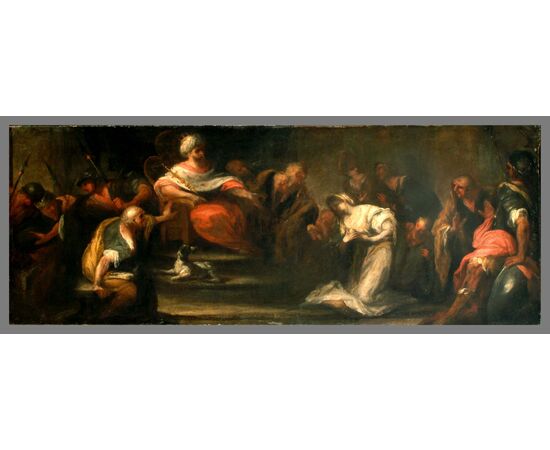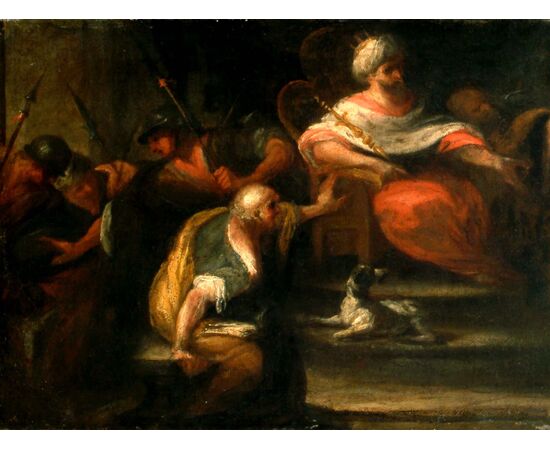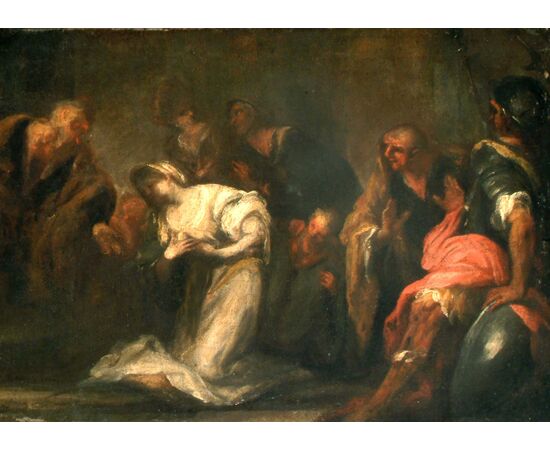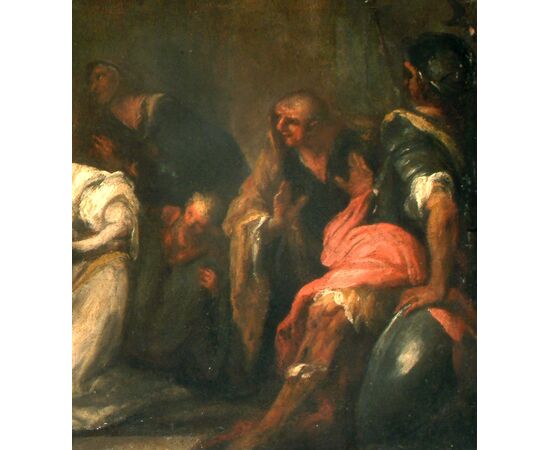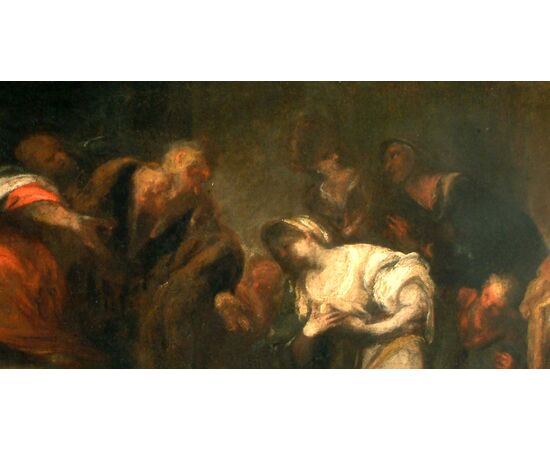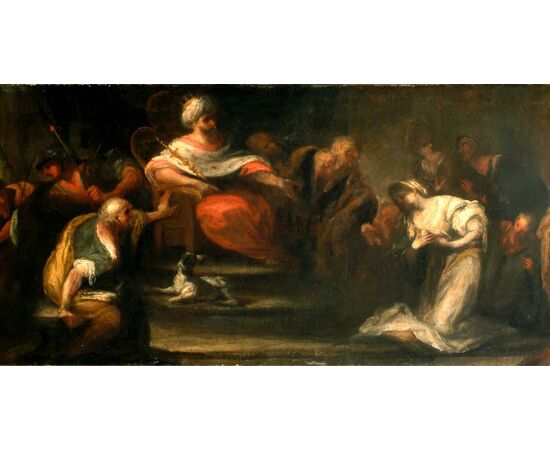Ester e Assuero dipinto ad olio su tela - Francesco Maria Raineri, detto lo Schivenoglia (Schivenoglia, Mantova 1676-1758)
Francesco Maria Raineri, detto lo Schivenoglia
(Schivenoglia, Mantova 1676-1758)
Ester e Assuero
dipinto ad olio su tela
Misura: cm 52x137
Opera esposta durante la mostra dedicata all’omonimo pittore:
“Francesco Maria Raineri - Lo Schivenoglia 1676-1758, opere da collezioni private”
e pubblicata nel catalogo, pag 13.
Ester è la figlia di Abicàil della tribù di Beniamino, una delle due tribù che costituivano il Regno di Giuda prima della sua distruzione da parte dei babilonesi e la deportazione, nel 597, dell'élite del regno nelle province dell'impero persiano.
Alla morte dei genitori è adottata dal cugino Mardocheo il quale occupa una funzione amministrativa nel palazzo reale a Susa. Avendo sentito che il re Assuero cerca una nuova sposa, Mardocheo fa partecipare la cugina Ester alle selezioni. Ester viene scelta e diventa la sposa di Assuero.
Quando il primo ministro Aman decide di sterminare tutti i giudei del regno, Mardocheo, che ha sempre vegliato su Ester, la esorta a presentarsi al re per intercedere in favore dei propri connazionali. Sebbene fosse proibito con pena di morte accedere al re senza essere convocati, dopo un digiuno di tre giorni Ester si presenta davanti al re per domandargli il favore di accettare il suo invito a cena con Aman.
Durante la cena li invita nuovamente e durante il secondo banchetto informa il re di essere giudea e che Aman ha decretato lo sterminio di tutti i giudei del regno.
Ottiene allora dal re il diritto per i giudei di difendersi il giorno in cui dovevano essere sterminati.
Nel nostro dipinto è rappresentato il momento nel quale Ester si rivolge al re Assuero.
Francesco Maria Raineri
Quinto di sette figli, quattro maschi e tre femmine, nato da Laura Tomirotti e da Angelo Raineri, entrambi benestanti, rimase orfano da giovane di entrambi i genitori (la madre muore nel 1681 e il padre nel 1694). Per questo, è molto probabile che il Raineri sia stato avviato per l'istruzione a Mantova presso un collegio o convitto religioso dove oltre il normale insegnamento del leggere e scrivere e far di conto avrà appreso anche il gusto per l'arte, dato che in quel tempo ancora nella città di Mantova esistevano notevoli capolavori sparsi tra la reggia Gonzaga, il Te, le case patrizie, le chiese.
Detto “Lo Schivenoglia”, fu allievo di Giovanni Canti da cui apprese la tecnica di una pittura stesa velocemente con pennellate rapide e decise. Superò di gran lunga il maestro e raggiunse livelli eccelsi grazie al suo spessore inventivo, all'originalità e all'estro pittorico, all'abilità nel disegno, alla novità della sua programmata asimmetria che porta ad un'innovazione dell'estetica e della composizione spaziale delle tele.
Collaborò su tele e affreschi con Bazzani (1690-1769), anch'egli allievo del Canti.
Dipinse battaglie, scene mitologiche, ritratti, figure sacre, scene religiose e paesaggi. È stato definito il “surrealista del Settecento mantovano”. Si rapportò sia alla pittura lombarda che a quella emiliana. Tenne una scuola di pittura.
Fu nominato primo direttore dell'Accademia delle Belle Arti di Mantova (detta anche Teresiana) nel 1753. L'Accademia fu fondata da Giovanni Cadioli (pittore) nel 1752 dopo l'autorizzazione di Maria Teresa d'Austria. A Giovanni Cadioli, preparatore delle tele dei dipinti e pittore, e ad Antonio Bonoris, pittore, lasciò in eredità (come da testamento) tutto il suo studio.
L’oggetto è provvisto dell’attestato di libera circolazione, rilasciato dal Ministero per i beni culturali, che ne certifica l’epoca e dà al bene la possibilità di essere esportato.
L'opera, come ogni altro nostro oggetto, sarà venduta corredata da attestati di autenticità e lecita provenienza.
Ci occupiamo e organizziamo personalmente l'imballaggio e la spedizione delle opere d'arte con assicurazione in tutto il mondo
ENGLISH
Francesco Maria Raineri, known as Schivenoglia
(Schivenoglia, Mantua 1676-1758)
Esther and Ahasuerus
oil painting on canvas
Size: 52x137 cm
Work exhibited during the exhibition dedicated to the homonymous painter:
“Francesco Maria Raineri - Lo Schivenoglia 1676-1758, works from private collections”
and published in the catalogue, page 13.
Esther is the daughter of Abicàil of the tribe of Benjamin, one of the two tribes that made up the Kingdom of Judah before its destruction by the Babylonians and the deportation, in 597, of the kingdom's elite to the provinces of the Persian empire.
On the death of her parents she is adopted by her cousin Mordecai who occupies an administrative function in the royal palace in Susa. Having heard that King Ahasuerus is looking for a new bride, Mordecai has his cousin Esther take part in the selections. Esther is chosen and becomes the wife of Ahasuerus.
When the prime minister Haman decides to exterminate all the Jews in the kingdom, Mordecai, who has always watched over Esther, urges her to present herself to the king to intercede on behalf of her fellow countrymen. Although it was forbidden on pain of death to enter the king without being summoned, after a three-day fast Esther appeared before the king to ask him the favor of accepting his invitation to supper with Haman.
During supper she invites them again and during the second banquet she informs the king that she is a Jew and that Haman has decreed the extermination of all the Jews in the kingdom.
She then obtains from the king the right for the Jews to defend themselves on the day they were to be exterminated.
Our painting represents the moment in which Esther addresses King Assuero.
Francesco Maria Raineri
Fifth of seven children, four boys and three girls, born to Laura Tomirotti and Angelo Raineri, both wealthy, he was orphaned of both parents when young (his mother died in 1681 and his father in 1694). For this reason, it is very probable that Raineri was sent to education in Mantua at a religious college or boarding school where, in addition to the normal teaching of reading and writing and arithmetic, he also learned a taste for art, given that in that time still in the city of Mantua there were notable masterpieces scattered among the Gonzaga palace, the Te, the patrician houses, the churches.
Known as "Lo Schivenoglia", he was a pupil of Giovanni Canti from whom he learned the technique of a painting spread quickly with rapid and decisive brushstrokes. He far surpassed the master and reached sublime levels thanks to his inventive depth, originality and pictorial flair, drawing ability, the novelty of his programmed asymmetry which leads to an innovation of aesthetics and composition space of the canvases.
He collaborated on canvases and frescoes with Bazzani (1690-1769), also a pupil of Canti.
He painted battles, mythological scenes, portraits, sacred figures, religious scenes and landscapes. He has been defined as the "Surrealist of the Mantuan eighteenth century". He related to both Lombard and Emilian painting. He held a school of painting.
He was appointed first director of the Mantua Academy of Fine Arts (also called Teresiana) in 1753. The Academy was founded by Giovanni Cadioli (painter) in 1752 after the authorization of Maria Theresa of Austria. To Giovanni Cadioli, preparer of the canvases of the paintings and painter, and to Antonio Bonoris, painter, he bequeathed (as per his will) all his studio of him.
The object is provided with the certificate of free circulation, issued by the Ministry of Cultural Heritage, which certifies its age and gives the object the possibility of being exported.
The work, like all our other objects, will be sold accompanied by certificates of authenticity and lawful origin.
We personally take care of and organize the packing and shipping of the artworks with insurance all over the world
FRANÇAIS
Francesco Maria Raineri, dit Schivenoglia
(Schivenoglia, Mantoue 1676-1758)
Esther et Assuérus
peinture à l'huile sur toile
Taille : 52x137 cm
Œuvre exposée lors de l'exposition consacrée au peintre homonyme :
« Francesco Maria Raineri - Lo Schivenoglia 1676-1758, œuvres de collections privées »
et publié dans le catalogue, page 13.
Esther est la fille d'Abicàil de la tribu de Benjamin, l'une des deux tribus qui composaient le royaume de Juda avant sa destruction par les Babyloniens et la déportation, en 597, de l'élite du royaume vers les provinces de l'empire perse.
A la mort de ses parents, elle fut adoptée par son cousin Mardochée qui occupait une fonction administrative au palais royal de Suse. Ayant appris que le roi Assuérus cherchait une nouvelle épouse, Mardochée fait participer sa cousine Esther aux sélections. Esther est choisie et devient la femme d'Assuérus.
Lorsque le Premier ministre Haman décide d'exterminer tous les Juifs du royaume, Mardochée, qui a toujours veillé sur Esther, l'exhorte à se présenter au roi pour intercéder en faveur de ses compatriotes. Bien qu'il fût interdit sous peine de mort d'entrer chez le roi sans être convoqué, après un jeûne de trois jours, Esther se présenta devant le roi pour lui demander la faveur d'accepter son invitation à souper avec Haman.
Au cours du dîner, elle les invite à nouveau et au cours du deuxième banquet, elle informe le roi qu'elle est juive et qu'Haman a décrété l'extermination de tous les Juifs du royaume.
Il obtint alors du roi le droit pour les Juifs de se défendre le jour où ils devaient être exterminés.
Notre tableau représente le moment où Esther s'adresse au roi Assuero.
Francesco Maria Raineri
Cinquième de sept enfants, quatre garçons et trois filles, nés de Laura Tomirotti et Angelo Raineri, tous deux riches, il est devenu orphelin de ses deux parents (sa mère est décédée en 1681 et son père en 1694). Pour cette raison, il est très probable que Raineri ait été envoyé à l'enseignement à Mantoue dans un collège religieux ou un internat où, en plus de l'enseignement normal de la lecture, de l'écriture et du calcul, il a également appris le goût de l'art, étant donné que dans ce temps encore dans la ville de Mantoue il y avait des chefs-d'œuvre notables dispersés entre le palais Gonzaga, le Te, les maisons patriciennes, les églises.
Connu sous le nom de "Lo Schivenoglia", il fut l'élève de Giovanni Canti auprès duquel il apprit la technique de la peinture rapidement diffusée avec des coups de pinceau rapides et décisifs. Il a largement dépassé son maître et atteint d'excellents niveaux grâce à sa profondeur inventive, son originalité et son flair pictural, sa capacité de dessin, la nouveauté de son asymétrie programmée qui conduit à une innovation dans l'esthétique et la composition spatiale des toiles.
Il a collaboré sur des toiles et des fresques avec Bazzani (1690-1769), également élève de Canti.
Il peint des batailles, des scènes mythologiques, des portraits, des personnages sacrés, des scènes religieuses et des paysages. Il a été défini comme le "Surréaliste du XVIIIe siècle de Mantoue". Il s'est lié à la fois à la peinture lombarde et émilienne. Il a tenu une école de peinture.
Il est nommé premier directeur de l'Académie des beaux-arts de Mantoue (également appelée Teresiana) en 1753. L'Académie est fondée par Giovanni Cadioli (peintre) en 1752 après l'autorisation de Marie-Thérèse d'Autriche. A Giovanni Cadioli, préparateur des toiles des tableaux et peintre, et à Antonio Bonoris, peintre, il lègue (selon son testament) tout son atelier.
L'objet est fourni avec le certificat de libre circulation, délivré par le ministère du Patrimoine culturel, qui certifie son âge et donne à l'objet la possibilité d'être exporté.
L'œuvre, comme tous nos autres objets, sera vendue accompagnée de certificats d'authenticité et d'origine licite.
Nous nous occupons et organisons personnellement l'emballage et l'expédition des œuvres avec assurance dans le monde entier.

